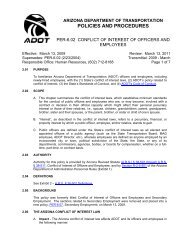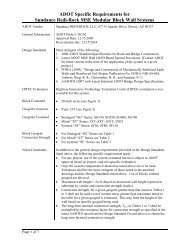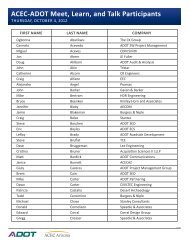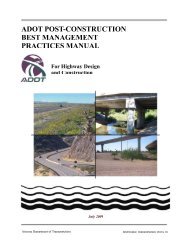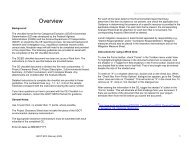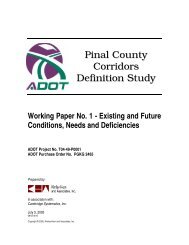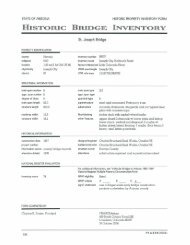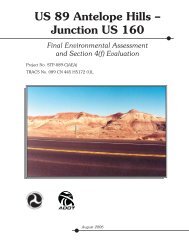I-10 Twin Peaks Traffic Interchange, Environmental Assessment
I-10 Twin Peaks Traffic Interchange, Environmental Assessment
I-10 Twin Peaks Traffic Interchange, Environmental Assessment
You also want an ePaper? Increase the reach of your titles
YUMPU automatically turns print PDFs into web optimized ePapers that Google loves.
Affected Environment and <strong>Environmental</strong> Impacts October 2005<br />
1988). The list of federal wildlife species used in this report was developed from<br />
the federally listed, proposed, and candidate wildlife species for Pima County from<br />
the U.S. Fish and Wildlife Service’s (USFWS) Arizona Ecological Field Office<br />
website. The species list contains 16 endangered and threatened, 1 proposed<br />
endangered, and 2 candidate wildlife species (Table 4-3). It was determined that<br />
listed species or suitable habitat could be impacted by the Preferred Alternative;<br />
therefore, a Biological Evaluation (BE) was prepared. The findings of this BE,<br />
entitled Interstate <strong>10</strong> <strong>Traffic</strong> <strong>Interchange</strong> at <strong>Twin</strong> <strong>Peaks</strong>/Linda Vista Biological<br />
Evaluation, July 27, 2004 is summarized below.<br />
Of the 19 species described above, 13 were not evaluated further because the<br />
project area is either: 1) clearly outside of the known geographic or elevational<br />
range of the species, or, 2) does not contain habitat characteristics known to<br />
support the species. Of the six remaining species, one federally listed species,<br />
cactus ferruginous pygmy-owl (Glaucidium brasilianum cactorum), has been<br />
documented by Arizona Game and Fish Department (AGFD) as occurring within<br />
two miles of the study area. Furthermore, the study area contains suitable habitat<br />
for five additional federally listed species: desert pupfish (Cyprinodon<br />
macularius), Gila chub (Gila intermedia), Gila topminnow (Poeciliopsis<br />
occidentalis occidentalis), southwestern willow flycatcher (Empidonax traillii<br />
extimus), and yellow-billed cuckoo (Coccyzus americanus). Each of these species<br />
is discussed below.<br />
Table 4-3. Special Status Wildlife Species<br />
Common Name Scientific Name Status<br />
Bald Eagle Haliaeetus leucocephalus Threatened<br />
Cactus Ferruginous Pygmy-Owl Glaucidium brasilianum cactorum Endangered<br />
California Brown Pelican Pelecanus occidentalis californicus Endangered<br />
Chiricahua Leopard Frog Rana chiricahuensis Threatened<br />
Desert Pupfish Cyprinodon macularius Endangered<br />
Gila Topminnow Poeciliopsis occidentalis occidentalis Endangered<br />
Jaguar Panthera onca Endangered<br />
Lesser Long-nosed Bat Leptonycteris curasoae yerbabuenae Endangered<br />
Loach Minnow Tiaroga cobitis Threatened<br />
Masked Bobwhite Colinus virginianus Endangered<br />
Mexican Gray Wolf Canis lupus baileyi Endangered<br />
Mexican Spotted Owl Strix occidentalis lucida Threatened<br />
Ocelot Leopardus pardalis Endangered<br />
Sonoran pronghorn Antilocapra americana sonoriensis Endangered<br />
Southwestern Willow Flycatcher Empidonax traillii extimus Endangered<br />
Spikedace Meda fulgida Threatened<br />
Gila Chub Gila intermedia Proposed<br />
Endangered<br />
Sonoyta Mud Turtle Kinosternon sonoriense longifemorale Candidate<br />
Yellow-billed Cuckoo Coccyzus americanus Candidate<br />
Interstate <strong>10</strong> <strong>Traffic</strong> <strong>Interchange</strong> at<br />
<strong>Twin</strong> <strong>Peaks</strong>/Linda Vista<br />
4-27<br />
Project No.: NH-0<strong>10</strong>-D (AIW)<br />
TRACS No.: <strong>10</strong> PM 236 H5838 01D



